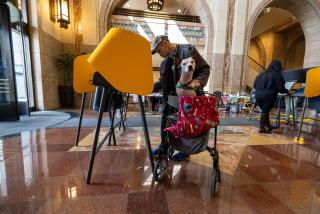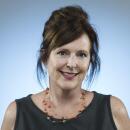Effort would consolidate L.A. elections with state and federal voting
- Share via
Hoping to reverse years of dismal voter turnout for Los Angeles city and school board elections, advocates recently kicked off what they say will be a “robust” campaign supporting two ballot measures to change when residents go to the polls.
Charter Amendments 1 and 2 would consolidate city and school board contests with state and federal elections starting in 2020. Currently, the City Charter requires city elections to be held in March and May of odd-numbered years, whereas state and federal balloting takes place in June and November of even-numbered years.
------------
FOR THE RECORD
Jan. 16, 11:27 a.m.: An earlier version of this article contained several errors. Campaign spokesman Dave Jacobson’s last name was misspelled as Jacobsen. City Councilman Bernard C. Parks Sr. was misidentified as Jr. And the name of the East Area Progressive Democrats was misstated as East Area Valley Democrats.
------------
It’s time to change that, supporters say, citing long-term declines in voter turnout. In May 2013, 23% of voters participated in the mayoral runoff between Wendy Greuel and Eric Garcetti. The primary drew 21%.
“An election with 20% of voters participating is democracy in name only,” said Dan Schnur, a former chairman of the California Fair Political Practices Commission and co-chairman of a newly formed campaign committee in support of the measures. “We know that voters are much more likely to pay attention to a presidential campaign. Rather than trying to fight that, it makes more sense to make this a larger conversation in which many Angelenos can participate.”
Citizens for Increased Voter Participation, formed earlier this week, announced it would be led by Schnur and two other co-chairs. They are Kathay Feng, executive director of California Common Cause, a public advocacy group, and Fernando Guerra, a Loyola-Marymount political science professor and chair of a citizens’ panel convened by City Council President Herb Wesson to explore ways to boost voting.
Dave Jacobson, a campaign spokesman, said the group was creating a website to disseminate information and collect contributions. The portal will be up and running in about a week, he said. Reaching voters citywide is expected to be costly — veteran campaign managers say a winning effort could take millions of dollars — but Jacobson declined to provide a specific fundraising target.
“At this early stage in the race, it’s difficult to put a precise dollar figure on the amount we’ll raise,” he said. “Our goal is to raise whatever is necessary to get our message out to voters throughout Los Angeles.”
Jacobson calls it a grass-roots effort that will have success only with broad support from communities across Los Angeles. The measures also have the support of city power brokers in the business community, organized labor and the political establishment. On Tuesday, they picked up two influential endorsements, the Los Angeles League of Women Voters and the Los Angeles League of Conservation Voters.
The proposed switch was championed by Wesson and placed on the ballot by the full council late last year. Panels have recommended changing the timing of city elections, saying it would draw more minority and younger voters while decreasing the influence of special interests on city governance.
But the amendments aren’t without opposition. Councilman Bernard C. Parks Sr., who voted against drafting the measures, has voiced concerns about turning the administration of elections over to Los Angeles County election officials, who normally conduct state and federal contests. In a ballot argument against the change, Parks and other opponents also criticized a provision that allows reelected candidates to get an extra 18 months in office while waiting for the consolidating balloting in 2020.
Mayor Garcetti, for instance, would serve a term of 5 1/2 years instead of four if he were reelected in 2017. Supporters say the longer term is a one-time adjustment to align cycles. Hector Huezo of the East Area Progressive Democrats also finds fault with the measures. Municipal candidates would be competing for people’s attention and trying to raise campaign money at the same time as presidential and gubernatorial candidates, Huezo said.
“The big federal and statewide issues would take the main stage,” he said. “That distracts people from electing local representatives that would do the best for their communities.”
Recent studies have shown that declining turnout is a problem not only in Los Angeles but across the country. Turnout for New York Mayor Bill de Blasio’s election in 2013 was a record low 24%. In one study of California city elections by researchers at UC Berkeley, average turnout was 26% in odd-numbered years.
“To put it simply, more voters are drawn to the polls for national and statewide elections than for local elections,” Sarah F. Anzia, a public policy professor at UC Berkeley, said in a letter to the Los Angeles City Council supporting a change.
Anzia said 88% of states still hold some or all of their municipal elections, and 77% of school board elections, in off-cycle years, a vestige of the Progressive reform movement of the early 20th century. She said her research showed that low turnout increases the effectiveness of organized groups because they have outsized influence over city policy.
Follow @csaillant2 for more news from L.A. City Hall.
More to Read
Sign up for Essential California
The most important California stories and recommendations in your inbox every morning.
You may occasionally receive promotional content from the Los Angeles Times.











